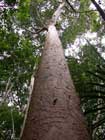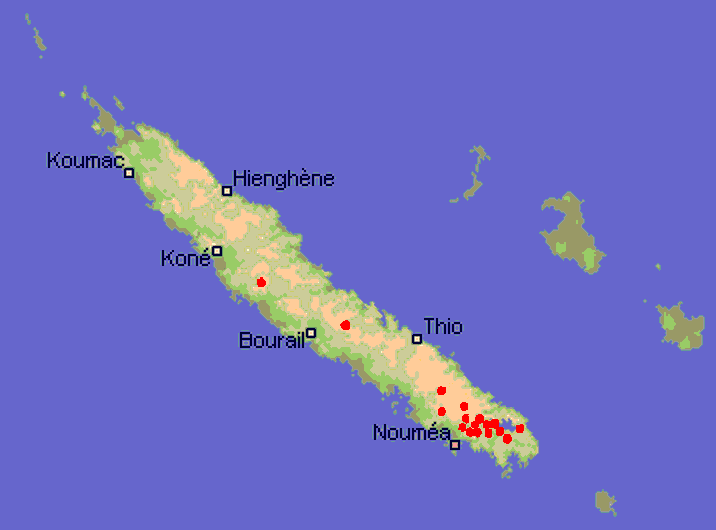
A tree in habitat [Adam Black, 2020.02.09, Facebook post].

Foliage on a tree in habitat [Adam Black, 2020.02.09, Facebook post].

Bark on a tree in habitat [Adam Black, 2020.02.09, Facebook post].

Grand kaori at Parc Riviere Blue, New Caldonia [Phill Parsons].

Mature tree in lowland rain forest at 540 m altitude, Vallèe des Kaoris, Monts Koghis, southern New Caledonia [Timothy Waters 2003].

Video on New Caledonia vegetation; A. lanceolata is featured starting at 10:30 and again at 25:20 [Crime Pays But Botany Doesn't 2020.02.09].

Herbarium collections of this species (de Laubenfels 1972).

Conservation Status

Agathis lanceolata
(Lindl. ex Sebert et Pancher) Warb. 1900
Common names
Koghis kauri (Silba 1986), kaori (Schmid 1981).
Taxonomic notes
One of 5 species of Agathis endemic to New Caledonia (Schmid 1981).
Description
Trees to 40 m tall, sometimes free of branches for 15 m. Crown irregular, dense with ascending branches. Twigs in whorls of 4. Bark red-brown, finely scaly. Bud globular, 4-8 mm diameter; scales numerous, imbricate. Juvenile leaves attenuate, 9 × 3.5 cm, on a short peduncle. Adult leaves lanceolate to elliptic, 6-8 × 1.6-2 cm, dark green above, non-glaucous below, margins pale and recurved, apex acute. Pollen cones in opposite pairs in axils of the leaves, cylindrical, 13-23 × 7-10 mm, on a peduncle 2-4 mm long; microsporophylls imbricate, entire, head subreniform. Seed cone ovoid to globular, 12 × 10 cm, scales broadly rounded. Seed ovoid, 12-15 × 7 mm with a wide spreading wing 20 × 13 mm (Silba 1986). See García Esteban et al. (2004) for a detailed characterization of the wood anatomy.
Distribution and Ecology
New Caledonia: type near Mt. Koghis, at 100-900 m elevation (Silba 1986). Typically growing as an emergent on ultramafic soils in the central and southern parts of the island, it is the largest tree in forests developed on ultramafic soils (Schmid 1981).
This maps shows all native species Agathis in New Caledonia, keyed by color; A. lanceolata is yellow. Click on an icon for further information. Distribution data from GBIF (2020.03.30), edited to remove duplicates.
The IUCN reports that this species is facing a high risk of extinction in the wild due to a restricted and highly fragmented distribution, coupled with continued declines in both the extent of habitat and the size of the population; no population is thought to contain more than 1,000 mature individuals. The WCMC notes that "The species continues to be overexploited. The species is also sensitive to wildfires and in some places it has retreated to sheltered valleys. There is effective protection of populations occurring in Rivière Bleu Provincial Park."
Remarkable Specimens
No data as of 2023.02.22.
Ethnobotany
No data as of 2023.02.22.
Observations
No data as of 2023.02.22.
Remarks
The epithet refers to the leaves, especially the juvenile leaves, which are often lanceolate.
Citations
See also
Association Endemia, a site devoted to New Caledonian species. Has excellent photos, a range map, and other information. In French.
The species account at Threatened Conifers of the World.
de Laubenfels (1972).







